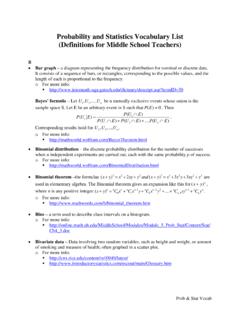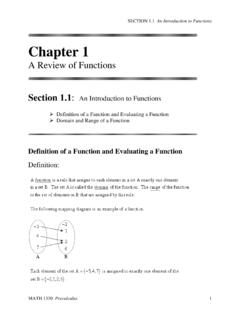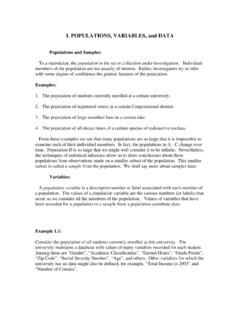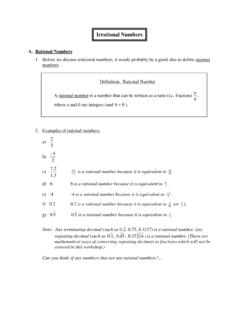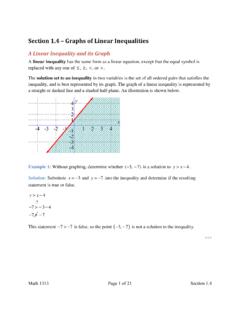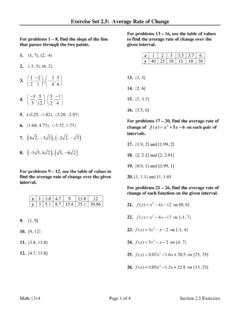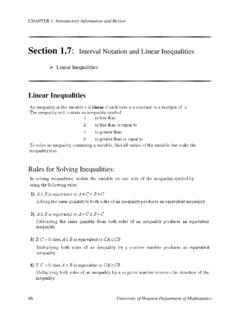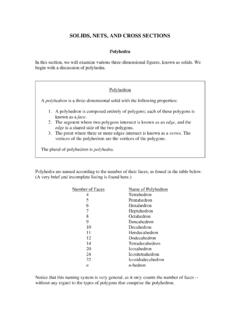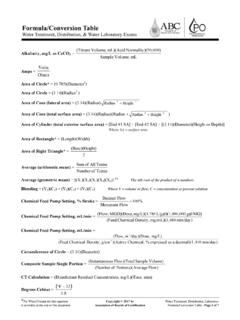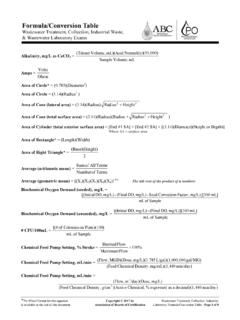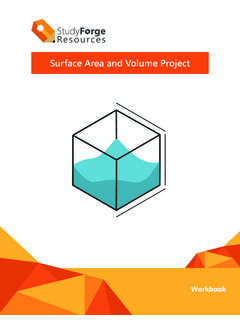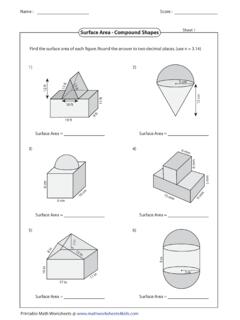Transcription of SURFACE AREA AND VOLUME - University of Houston
1 SURFACE area AND VOLUME In this unit, we will learn to find the SURFACE area and VOLUME of the following three-dimensional solids: 1. Prisms 2. Pyramids 3. Cylinders 4. Cones It is assumed that the reader has basic knowledge of the above solids and their properties from the previous unit entitled Solids, Nets and Cross Sections. Some basic terminology for this section can be found below. Lateral area : The lateral area of a prism or pyramid is the combined area of its lateral faces. Similarly, the lateral area of a cylinder or cone is the area of its lateral SURFACE .
2 Examples: Given a bedroom in the shape of a rectangular prism, the lateral area is the area of the four walls. Given a cylindrical soup can, the lateral area is the area of the can s label. Total SURFACE area : The total SURFACE area of a prism or pyramid is the combined area of its lateral faces and its base(s). Similarly, the total SURFACE area of a cylinder or cone is the combined area of its lateral SURFACE and its base(s). The total SURFACE area of a solid can also be thought of as the area of the solid s net. Examples: Given a bedroom in the shape of a rectangular prism, the total SURFACE area is the area of the four walls plus the area of the ceiling and the floor.
3 Given a cylindrical soup can, the total SURFACE area is the area of the can s label plus the combined area of the top and bottom of the can. VOLUME : The VOLUME of a solid is the number of cubic units which fit inside the solid. Example: Given a cylindrical soup can, the VOLUME is the amount of soup which can be contained inside of the can. SURFACE area & VOLUME of a Prism SURFACE area of a Prism Suppose that we want to find the lateral area and total SURFACE area of the following right triangular prism: The bases of this prism are right triangles, and the lateral faces are rectangles, as shown below.
4 Bases Lateral Faces 3 cm5 cm6 cm4 cm3 cm4 cm 5 cm3 cm4 cm5 cm4 cm6 cm3 cm 6 cm 5 cm 6 cmThe lateral area of the triangular prism is the sum of the areas of the lateral faces; the sum of the areas of the three rectangles. () ()()3 64 65 618 24 30 72 Lateral area =++=++= cm2 The total SURFACE area of the triangular prism is the lateral area plus the area of the two bases. 2 Total SURFACE AreaLateral AreaArea ofBases=+ ()()()()1122723434=+ + 7266=++ 84= cm2 There is a bit of a shortcut for finding the lateral area of a prism.
5 In the equation for the lateral area , notice that we can factor out a 6: () ()()()36 46 563 4 5 6 Lateral area =++=++ cm2 In the formula above, ()345++ represents the perimeter of the base, and 6 represents the height. The general formulas for the lateral area and total SURFACE area of a right prism are shown below. Lateral area of a Right Prism The lateral area L of a right prism is represented by the formula: LPh=, where P represents the perimeter of a base and h represents the height of the SURFACE area of a Right Prism The total SURFACE area T of a right prism is represented by the formula: 2TL B=+, where L represents the lateral area of the prism and B represents the area of a Answer the following.
6 Be sure to include units. (Figures may not be drawn to scale.) 1. The following figure is a rectangular right prism. In a rectangular right prism, any set of opposite faces can be considered to be the bases (since the bases of a prism are defined to be the polygonal faces that lie in parallel planes). a) Find the lateral area and the total SURFACE area of the prism, assuming that the 3x5 cm rectangles are the bases. b) Find the lateral area and the total SURFACE area of the prism, assuming that the 3x7 cm rectangles are the bases. 2. The following figure is a regular right prism.
7 Find the lateral area and the total SURFACE area of the prism. Solutions: 1. a) Assuming that the 3x5 cm rectangles are the bases: The perimeter P of a base is 353516P=+++= cm. The height h of the prism is 7 cm. The lateral area of the prism is ()16 7112 LPh== = cm2. The area of a base is ()35 15B== cm2. The total SURFACE area is ()2112 2 15142TL B=+ = + = cm2. 3 cm5 cm7 cm8 in20 inb) Assuming that the 3x7 cm rectangles are the bases: The perimeter P of a base is 3737 20P=+++= cm. The height h of the prism is 5 cm. The lateral area of the prism is ()20 5100 LPh== = cm2.
8 The area of a base is ()37 21B== cm2. The total SURFACE area is ()2100 2 21142TL B=+ = + = cm2. 2. The bases of the prism are regular hexagons. The perimeter P of a base is ()68 48P== in2. The height h of the prism is 20 in. The lateral area of the prism is ()48 20960 LPh== = in2. To find the area B of the base, we must use the formula 12 BaP= (the formula for the area of a regular polygon). The apothem, a, is 4 3 in. (For a detailed description of how to find the apothem and area of a regular polygon, refer to the unit entitled Perimeter and area and then refer to the last section in the unit, entitled area of a Regular Polygon.)
9 Since the perimeter P of the regular hexagon is 48 in, ()()11224 3 4896 3 BaP=== in2. Therefore, the total SURFACE area of the regular hexagonal prism is ()()2960 2 96 3960 192 3TL B=+ = += + in2. Note: The above terms are not like terms and cannot be combined, since one term contains a radical symbol and the other does not. VOLUME of a Prism We are now going to informally develop the formula for the VOLUME of a prism. Consider the following right rectangular prism. 5 cm2 cm3 cm First, we find the area of the base. We will call this area B. ()32 6B== cm2.
10 The six square units of area are drawn on one of the bases in the diagram at the right. In the diagram at the right, each square unit of area on the base has now been used to draw a cubic unit of VOLUME . Six cubes are contained in this first layer of the prism which is one-centimeter thick. Since the prism has a height of 5 cm, there are five layers which are each one-centimeter thick. Since each layer contains six cubic units, the VOLUME V of the prism is ()65 30V== cm3. 5 cm2 cm3 cm 5 cm2 cm3 cm 5 cmThe above method leads us to a VOLUME formula that can be used for any prism.
